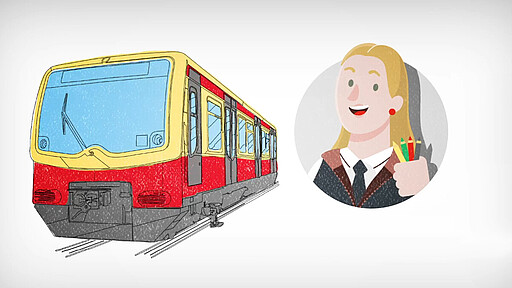Vehicle Fleet – Our Trains
Get to know our different vehicle generations, from historic trains all the way up to the latest S-Bahn model.
You’ve probably noticed that not all S-Bahn trains look the same. Right now, there are actually three three (or rather four) different production series riding Berlin’s rails and some of these have clocked up quite a few years of service, so they are nearing retirement. Others are currently receiving a thorough update and facelift as part of our Project Longevity and its 50 measures, while yet another series only just joined our roster.
On this page, we’d like to introduce you to our vehicle fleet – and the people who keep it in tip-top shape. Besides offering you a welcome glimpse behind the scenes, we would also like to familiarise you with a few technical terms – and lift some of the myths around the series nicknames. So, what connects Coca Cola, rapper Romano, 4 Blocks actor Rauand Taleb, and our S-Bahn trains? Read on for the answers and some essential information – not just for train buffs!
Our current S-Bahn fleet
Just how many trains and carriages does the S-Bahn have?
Before we answer this question, it’s important to clarify that the S-Bahn counts its stock in quarter trains. Each quarter train consists of two carriages and constitutes the smallest unit in scheduled service on Berlin’s rail network.

500 quarter trains of the 481 series, first introduced in 1996, make up the bulk of our fleet. Strictly speaking, there are 494 quarter trains and 3 walkthrough half-trains, with one half-train counting as two quarter trains (500 = 494 + 3 * 2).
These are joined by 65 quarter trains of the 480 series, which has been in service since 1987.
We also have 21 quarter trains of our latest vehicle generation, the 483 series, and 85 half trains (equivalent to 170 quarter trains) of it's sister model, the the 484 series. As with the 481 series, one half train of the 484 series counts as two quarter trains.
So, the active S-Bahn fleet consists of 761 quarter trains or 1512 carriages. (Status: august 2023)
What is the maximum length of an S-Bahn train?
Depending on passenger volumes, the S-Bahn deploys trains of different lengths on different routes. In S-Bahn terminology, these varying lengths have their own correct terms: quarter train, half train, three-quarter train, and full train.
As previously mentioned, quarter trains (two carriages) are the smallest operating unit. When two quarter trains are combined, the resulting unit is called a half train (four carriages). If you connect a half train and a quarter train, you get a three-quarter train (six carriages), and eight connected carriages make up a full train.
For Berlin S-Bahn network infrastructure reasons, the maximum train length is limited to eight carriages (limiting factors include signal distances and platform lengths).
Trains on regular network routes only combine carriages from the same series. For the 481 and 485 series, the smallest service unit is a half train, while the 480 and 483 series can also be used as quarter trains since each carriage comes with its own driver’s cab.
Good to know: Some trains currently running on Berlin’s tracks were designed to serve as walkthrough half-trains. While this type of train is still a rarity – with three 481 series examples on active duty – the new S-Bahn will change all this. Of all 106 new trains currently under construction only 21 will be quarter trains (483 series), the remaining 85 units will be half trains (484 series).
How we repair our trains on the road and in our Fleet Maintenance Depots
The unmistakeable sound of the S-Bahn
Berliners know it only too well: the inimitable sound of S-Bahn doors. To comply with European standards, the new S-Bahn trains replace this familiar three-tone sequence with a new door opening and closing sound.
This doesn’t mean you won’t ever hear the old door sound again: It will still be used by older S-Bahn models. And those of you who simply can’t get enough of the distinctive mini-melody can download the combo here as an mp3 file (via right click and save as …).













